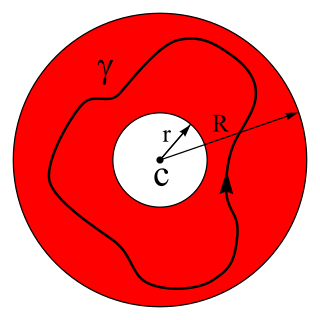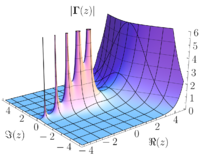Proof
The argument, first given by Cauchy, hinges on Cauchy's integral formula and the power series expansion of the expression

Let  be an open disk centered at
be an open disk centered at  and suppose
and suppose  is differentiable everywhere within an open neighborhood containing the closure of
is differentiable everywhere within an open neighborhood containing the closure of  . Let
. Let  be the positively oriented (i.e., counterclockwise) circle which is the boundary of
be the positively oriented (i.e., counterclockwise) circle which is the boundary of  and let
and let  be a point in
be a point in  . Starting with Cauchy's integral formula, we have
. Starting with Cauchy's integral formula, we have

Interchange of the integral and infinite sum is justified by observing that  is bounded on
is bounded on  by some positive number
by some positive number  , while for all
, while for all  in
in 

for some positive  as well. We therefore have
as well. We therefore have

on  , and as the Weierstrass M-test shows the series converges uniformly over
, and as the Weierstrass M-test shows the series converges uniformly over  , the sum and the integral may be interchanged.
, the sum and the integral may be interchanged.
As the factor  does not depend on the variable of integration
does not depend on the variable of integration  , it may be factored out to yield
, it may be factored out to yield

which has the desired form of a power series in  :
:

with coefficients


The Cauchy distribution, named after Augustin Cauchy, is a continuous probability distribution. It is also known, especially among physicists, as the Lorentz distribution, Cauchy–Lorentz distribution, Lorentz(ian) function, or Breit–Wigner distribution. The Cauchy distribution is the distribution of the x-intercept of a ray issuing from with a uniformly distributed angle. It is also the distribution of the ratio of two independent normally distributed random variables with mean zero.

In mathematical physics, the Dirac delta distribution, also known as the unit impulse, is a generalized function or distribution over the real numbers, whose value is zero everywhere except at zero, and whose integral over the entire real line is equal to one.

A Fourier series is an expansion of a periodic function into a sum of trigonometric functions. The Fourier series is an example of a trigonometric series, but not all trigonometric series are Fourier series. By expressing a function as a sum of sines and cosines, many problems involving the function become easier to analyze because trigonometric functions are well understood. For example, Fourier series were first used by Joseph Fourier to find solutions to the heat equation. This application is possible because the derivatives of trigonometric functions fall into simple patterns. Fourier series cannot be used to approximate arbitrary functions, because most functions have infinitely many terms in their Fourier series, and the series do not always converge. Well-behaved functions, for example smooth functions, have Fourier series that converge to the original function. The coefficients of the Fourier series are determined by integrals of the function multiplied by trigonometric functions, described in Common forms of the Fourier series below.

In mathematics, the Laurent series of a complex function is a representation of that function as a power series which includes terms of negative degree. It may be used to express complex functions in cases where a Taylor series expansion cannot be applied. The Laurent series was named after and first published by Pierre Alphonse Laurent in 1843. Karl Weierstrass may have discovered it first in a paper written in 1841, but it was not published until after his death.

In mathematics, Cauchy's integral formula, named after Augustin-Louis Cauchy, is a central statement in complex analysis. It expresses the fact that a holomorphic function defined on a disk is completely determined by its values on the boundary of the disk, and it provides integral formulas for all derivatives of a holomorphic function. Cauchy's formula shows that, in complex analysis, "differentiation is equivalent to integration": complex differentiation, like integration, behaves well under uniform limits – a result that does not hold in real analysis.

In mathematics, more specifically complex analysis, the residue is a complex number proportional to the contour integral of a meromorphic function along a path enclosing one of its singularities. Residues can be computed quite easily and, once known, allow the determination of general contour integrals via the residue theorem.

In complex analysis, the residue theorem, sometimes called Cauchy's residue theorem, is a powerful tool to evaluate line integrals of analytic functions over closed curves; it can often be used to compute real integrals and infinite series as well. It generalizes the Cauchy integral theorem and Cauchy's integral formula. From a geometrical perspective, it can be seen as a special case of the generalized Stokes' theorem.
In complex analysis, a branch of mathematics, analytic continuation is a technique to extend the domain of definition of a given analytic function. Analytic continuation often succeeds in defining further values of a function, for example in a new region where the infinite series representation which initially defined the function becomes divergent.
In complex analysis, Liouville's theorem, named after Joseph Liouville, states that every bounded entire function must be constant. That is, every holomorphic function for which there exists a positive number such that for all is constant. Equivalently, non-constant holomorphic functions on have unbounded images.

In complex analysis, a branch of mathematics, Morera's theorem, named after Giacinto Morera, gives an important criterion for proving that a function is holomorphic.
In mathematics and signal processing, the Hilbert transform is a specific singular integral that takes a function, u(t) of a real variable and produces another function of a real variable H(u)(t). The Hilbert transform is given by the Cauchy principal value of the convolution with the function (see § Definition). The Hilbert transform has a particularly simple representation in the frequency domain: It imparts a phase shift of ±90° (π⁄2 radians) to every frequency component of a function, the sign of the shift depending on the sign of the frequency (see § Relationship with the Fourier transform). The Hilbert transform is important in signal processing, where it is a component of the analytic representation of a real-valued signal u(t). The Hilbert transform was first introduced by David Hilbert in this setting, to solve a special case of the Riemann–Hilbert problem for analytic functions.
In mathematics, a Paley–Wiener theorem is any theorem that relates decay properties of a function or distribution at infinity with analyticity of its Fourier transform. The theorem is named for Raymond Paley (1907–1933) and Norbert Wiener (1894–1964). The original theorems did not use the language of distributions, and instead applied to square-integrable functions. The first such theorem using distributions was due to Laurent Schwartz. These theorems heavily rely on the triangle inequality.

In complex analysis, the argument principle relates the difference between the number of zeros and poles of a meromorphic function to a contour integral of the function's logarithmic derivative.
In mathematics, the Riesz–Fischer theorem in real analysis is any of a number of closely related results concerning the properties of the space L2 of square integrable functions. The theorem was proven independently in 1907 by Frigyes Riesz and Ernst Sigismund Fischer.
In mathematics, Borel summation is a summation method for divergent series, introduced by Émile Borel (1899). It is particularly useful for summing divergent asymptotic series, and in some sense gives the best possible sum for such series. There are several variations of this method that are also called Borel summation, and a generalization of it called Mittag-Leffler summation.
In mathematics, holomorphic functional calculus is functional calculus with holomorphic functions. That is to say, given a holomorphic function f of a complex argument z and an operator T, the aim is to construct an operator, f(T), which naturally extends the function f from complex argument to operator argument. More precisely, the functional calculus defines a continuous algebra homomorphism from the holomorphic functions on a neighbourhood of the spectrum of T to the bounded operators.
In mathematics, the Parseval–Gutzmer formula states that, if is an analytic function on a closed disk of radius r with Taylor series
In mathematics, singular integral operators of convolution type are the singular integral operators that arise on Rn and Tn through convolution by distributions; equivalently they are the singular integral operators that commute with translations. The classical examples in harmonic analysis are the harmonic conjugation operator on the circle, the Hilbert transform on the circle and the real line, the Beurling transform in the complex plane and the Riesz transforms in Euclidean space. The continuity of these operators on L2 is evident because the Fourier transform converts them into multiplication operators. Continuity on Lp spaces was first established by Marcel Riesz. The classical techniques include the use of Poisson integrals, interpolation theory and the Hardy–Littlewood maximal function. For more general operators, fundamental new techniques, introduced by Alberto Calderón and Antoni Zygmund in 1952, were developed by a number of authors to give general criteria for continuity on Lp spaces. This article explains the theory for the classical operators and sketches the subsequent general theory.
In mathematics, singular integral operators on closed curves arise in problems in analysis, in particular complex analysis and harmonic analysis. The two main singular integral operators, the Hilbert transform and the Cauchy transform, can be defined for any smooth Jordan curve in the complex plane and are related by a simple algebraic formula. In the special case of Fourier series for the unit circle, the operators become the classical Cauchy transform, the orthogonal projection onto Hardy space, and the Hilbert transform a real orthogonal linear complex structure. In general the Cauchy transform is a non-self-adjoint idempotent and the Hilbert transform a non-orthogonal complex structure. The range of the Cauchy transform is the Hardy space of the bounded region enclosed by the Jordan curve. The theory for the original curve can be deduced from that of the unit circle, where, because of rotational symmetry, both operators are classical singular integral operators of convolution type. The Hilbert transform satisfies the jump relations of Plemelj and Sokhotski, which express the original function as the difference between the boundary values of holomorphic functions on the region and its complement. Singular integral operators have been studied on various classes of functions, including Hőlder spaces, Lp spaces and Sobolev spaces. In the case of L2 spaces—the case treated in detail below—other operators associated with the closed curve, such as the Szegő projection onto Hardy space and the Neumann–Poincaré operator, can be expressed in terms of the Cauchy transform and its adjoint.
In mathematics, the Abel–Plana formula is a summation formula discovered independently by Niels Henrik Abel (1823) and Giovanni Antonio Amedeo Plana (1820). It states that





























